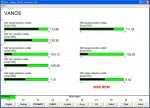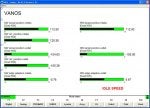I finally have INPA running and have been having a play about. I've been considering whether my VANOS seals need doing - I don't have any cold running symptoms, and power below 3krpm is pretty good (for a e46 1999 323 with 120k miles on the clock).
Based on the readings below, at idle and at just over 3krpm.. are my VANOS working ok?
Many thanks,
Mike
Based on the readings below, at idle and at just over 3krpm.. are my VANOS working ok?
Many thanks,
Mike






